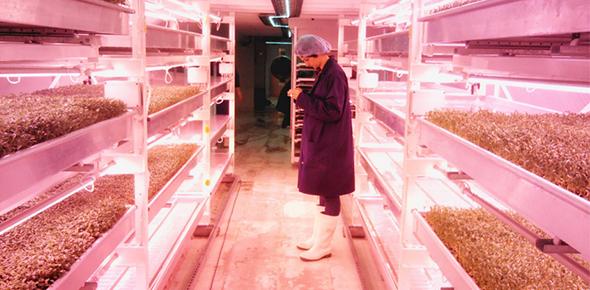
In the heart of London there is a farm like no other. It's subterranean, sustainable and energy smart. It also has a digital twin looking out for its every need. Thirty-three metres below London’s Clapham High Street is the world’s first underground farm. It’s shaping the future of urban farming.
Stacked racks of fresh green leaves thrive under banks of LED lights – peashoots, basil, coriander, parsley, salad rocket, pink radish, mustard plants – the fragrance of the ‘microgreens’ filling a former World War Two air raid shelter under south London.
A post-war plan to join the tunnels to the London Underground system never happened and, in 2015, the deserted subterranean space sprouted new life when co-founders Richard Ballard and Steve Dring decided it was a perfect site to grow food while cutting the amount of CO2 used in transport and supply.
Zero-carbon food is at the core of the Growing Underground vision – which means paying close attention to what happens to the plants below ground as well as above ground. Down in the tunnels, a team of engineers and data specialists has been helping the farmers to optimise crop performance and reduce energy use. They are led by Dr Ruchi Choudhary from the Centre for Smart Infrastructure and Construction (University of Cambridge) and the Data-centric Engineering Programme at the Alan Turing Institute.
This can only happen if every element of the farming process is carefully measured and tweaked and measured again. The plants on this farm get exactly what they need at every moment of every day thanks to the power of data – and a ‘digital twin’ looking out for its sibling from a laboratory in Cambridge.
By 2022, Growing Underground hopes to be producing over 60 tonnes of produce per year from a 528m2 area (roughly the size of one tennis court). That’s enough to meet the yearly lettuce consumption of 10,000 adults. Either side of the 2.5 m high passage, the plants grow without soil (‘hydroponically’) on wool carpet cut-offs that were destined for landfill, and watered from tanks housed on a lower level. The hydroponic system uses 70% less water than conventional agricultural methods. LED lights provide low-cost light for photosynthesis and maintain a constant temperature of around 22 °C./p>
The farm grows 12 times more per unit area than a traditional greenhouse grows in the UK but it also consumes four times more energy per unit area.
Melanie Jans-Singh (Department of Engineering) has installed 25 sensors measuring 89 variables transmitting to eight Raspberry Pi loggers in the tunnels. Everything you might want to know about how this garden grows. Back in Cambridge, she and colleagues set about building a digital twin
The researchers work closely with Growing Underground’s Data Platform Lead Jakob Thomas, who explained that the digital twin has another very important use: it’s guiding the growers in how to build another farm – this time in a disused warehouse that will supply an even larger area of London. “The digital twin allows us to simulate a hypothetical farm so well that in the engineering and planning phase we can pinpoint much more precisely what equipment we need to keep the environment stable and use the least amount of energy,” he explains.

